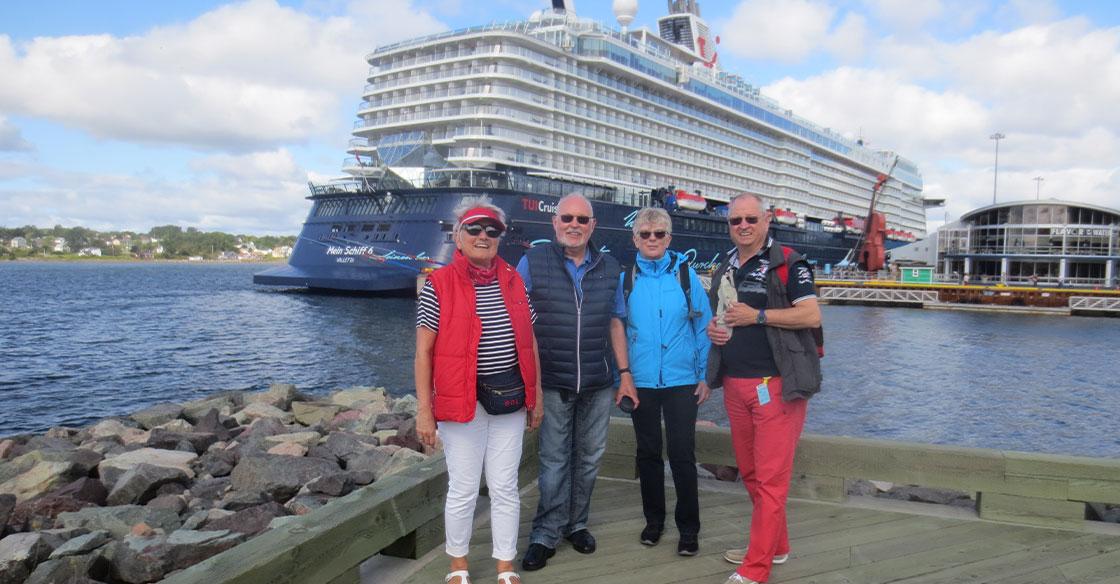
On September, 1, 2017, Silvia Graf began to experience intense chest pains while travelling from Sydney, N.S. to Halifax on a cruise ship.
“I suddenly became very ill and everybody was very anxious,” she recalls.
At first, the ship’s doctor told Silvia to remain calm and get some bed rest — assuring her that the pain was caused by too much stressful activity. But when tests revealed that Silvia was experiencing a significant heart event, the doctor realized her condition was beyond his ability to treat.
“The next morning, at about 8 a.m., we were in the harbour of Halifax,” Silvia remembers. “There was an ambulance waiting for me and I was taken from the ship to the hospital. And that was my good luck!”
Silvia’s good fortune came in the form of the QEII Health Sciences Centre and Dr. Greg Hirsch, chief of cardiac surgery. Silvia was treated in the emergency department where she had a computerized tomography (CT) scan; the results confirmed Silvia’s life-threatening diagnosis. Dr. Hirsch used the detailed images of Silvia’s aorta to develop her care plan.
“She had an intramural hematoma, which results from a split in the innermost layer of the aorta,” Dr. Hirsch explains. “The aorta is a multi-layer structure, like a laminate tabletop, and the inner lamina had split and blood was entering the middle layers.”
With the initial tear detected and the possibility that the condition might repair itself, Dr. Hirsch continued to observe Silvia over the next few days before repeating the scan.
“If Dr. Hirsch could not have done the surgery, I would not be alive.”
-Silvia Graf
“Ultimately, we identified the likely entry site and replaced that segment of her aorta,” he says. “This required a major cardiac operation requiring the use of a heart-lung machine to support her circulation while the major blood vessel exiting the heart was replaced. While this is a major intervention, our centre sees about 40 aortic emergencies a year, so it’s routine for us.”
Grasping the details of a complicated medical diagnosis and procedure is challenging enough, but for the native of Berlin, Germany, the language barrier was particularly daunting.
“My English isn’t strong, so when they were talking about my medical condition, it was problematic,” Silvia admits. “But they called Dr. Michael Vician, who spoke very good German. He translated everything and he was a big help.”
Above and beyond facilitating clear communication through Dr. Vician, director of the QEII’s cardiac and vascular intensive care unit, Silvia’s stay was memorable thanks to several key staff members.
“I had a visit from a volunteer,” Silvia recounts. “She’d had the same procedure so she could talk about the surgery, the recovery and how she was OK again. She calmed me down and gave me a lot of hope.”
Silvia also fondly remembers a nurse named Heather who always made her comfort paramount.
“I was always cold, so Heather had a wonderful idea to make me warmer with an intravenous drip and two warm hot water bottles for my feet.”
According to Dr. Hirsch, the QEII features a unique combination of top-tier staff and cutting-edge resources to help any visitor to Halifax deal with an unexpected health crisis.
Dr. Hirsch is also quick to point out that the synergy between the cardiac division and other affiliated departments is key to this level of effectiveness.
“We have a very close relationship with our cardiology and interventional radiology colleagues. Many situations require emergency interventions, including angioplasty and stent grafting, that avoid the need for open surgery. When open surgery is required, our radiology and cardiology colleagues provide quick access to the necessary diagnostic tests. “Working together, there isn’t a cardiac emergency that we can’t definitively handle,” says Dr. Hirsch.
While Silvia’s vacation ended at the QEII, she’s grateful for the high level of quality care she received.
“If Dr. Hirsch could not have done the surgery, I would not be alive,” she says. “It was very well done. Now, I have only to take some medicine every day and that’s all. I’m feeling totally fine!”
“There’s not an emergency I can think of that we couldn’t effectively deal with beginning to end here at the QEII,” Dr. Hirsch confirms. “I’m very proud of the fact that we’re able to provide these services to Atlantic Canadians and to our Canadian and international visitors.”